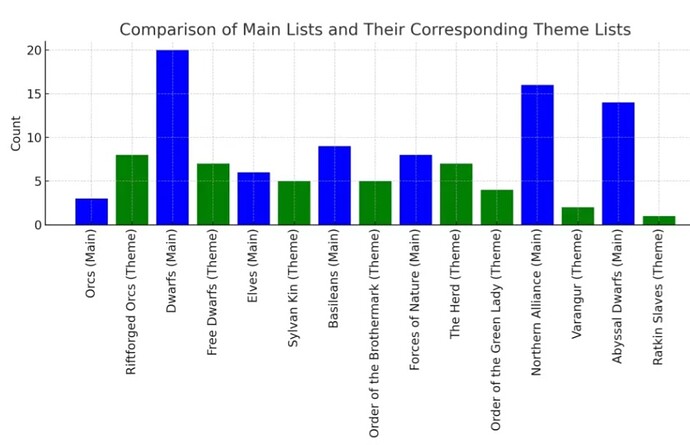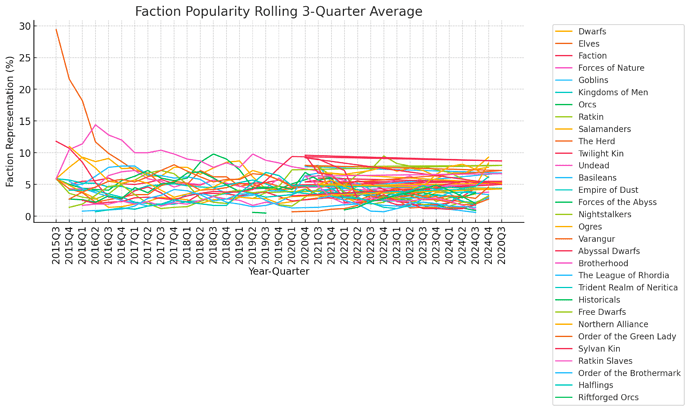I’m digging into this a bit. For theme lists, we have Twilight Kin, Free Dwarfs, Sylvan Kin, Brothermark, OOTGL, Varangur, Noble Undead, Ratkin Slaves, and Herd. Am I missing any?
Noble Undead aren’t a theme list - just an undead army that has taken Jarvis. It’s separated on the Companion for list building purposes as it removes the other LL heroes and swaps evil for good allies.
RFO are actually a theme list - even though they share so few units with the Orcs.
TK are a standalone list now (they used to be an elf theme)
Perfect. Thanks.
In response to @TastyBagel’s question:
Thanks for the data!
I think that there is more to it than main vs theme.
How the main and theme lists relate to each other varies, for a start.
Theme lists also seem to have less of what appears (i.e. from the impression I get, rather than data) to be correlated (positively) to faction popularity.
Faction popularity seems to increase with:
- General dedication. Some factions come with a concept and fans from Fantasy in general, which those fans carry with them into KoW. It’s why dwarfs are so popular, for example.
- Model availability. Especially if there are nice models from Mantic. Also people having suitable models already, but that appears to be becoming less important over time.
- Rules. I don’t like it, but it’s true.
- Company focus. Cool lore or updated rules. Often accompanied by model releases, though.
I would say that theme lists can relate to main lists in the following ways:
- Twist on play style. Presumably the main reason to have them lists; another option, that’s fun to have but never seems to be as popular.
- Home for a “legacy list”. Uncharted Empires lists that Mantic is still deciding what to do with or just need to put somewhere.
- Concept replacement. Mantic has released their take on a similar concept and made it their own. Usually with new models and Mantic IP lore. They don’t want to take the original away from people though. The new appears to outshine the old here. The term “legacy list” applies better here, but I’ll stick to existing usage.
From your the chart in the article:
- I think riftforged orc and orcs share the same general dedication for orcs, but riftforged orcs have far better model availability and rules. This looks like a concept replacement to me.
- Dwarfs have massive general dedication, which doesn’t seem to carry over into Free Dwarfs. Imperial Dwarfs feel very “dwarfy” to play, which reinforces that general dedication. Imperial Dwarfs also have slightly better model availability. I would also not expect a “twist on playstyle” to be as popular.
- The elves look fairly even. They have similar model availability, general dedication and rules, but I think that the main list offers more styles of elf than the one presented by the Sylvan Kin.
- I think that both Brotherhood lists are not really theme lists as much as legacy lists that need to go somewhere. They’re more themes of each other than anything else.
- Same goes for The Herd.
- Varangur have been replaced as concept by Northern Alliance. They’re now a twist with worsening model availability.
- Ratkin slaves should probably be compared to Ratkin and those rats are hoarding all the general dedication. It doesn’t help that Ratkin Slaves don’t have great rules and are a twist on playstyle that doesn’t quite justify being a separate list.
The introduction of flying LCav units in both NA & KoM definitely saw more take up over their respective theme lists - which seemed were previously fairly balanced in take up.
Definitely agree from a model perspective that NA are now way ahead of varangur - pretty much fully covered v a handful of units.
Newer, nicer sculpts and flyers give RFO a big plus over regular orcs.
Ratkin slaves an odd one - plenty of model availability, but only a couple of viable builds and the couple of players who seemed to use them regular in uk events have moved on to other projects.
Dwarfs - de6 and throwing mastiffs is a really strong build, while other lists can do the scouting/pathfinder thing which free dwarfs are strong at?
Great thoughts, guys. I updated the post to incorporate this.
A way to test the effect of model availability and rules would be to track the popularity of NA, nightstalkers, Twilight Kin and abyssals and see if the correlate to the relevant model releases (with a “painting lag”).
I thought about that, but I don’t think the Companion lists go back far enough to really build out the data set. Aware of any other datasets out there that could be used?
From a tournament perspective the UK Masters site will show the armies used at each event
Good idea. Let me see what I can pull together before the kids get up this morning. Does this look right from a model refresh/supported list? (Ignore the count column–I’m too lazy to strip it out this morning)
| Faction | Count | Last Refresh Year | Supported |
|---|---|---|---|
| Abyssal Dwarfs | 2 | 2020 | Y |
| Basileans | 2 | 2018 | Y |
| Dwarfs | 5 | 2011 | Y |
| Elves | 2 | 2011 | Y |
| Empire of Dust | 2 | 2022 | Y |
| Forces of the Abyss | 2 | 2015 | Y |
| Forces of Nature | 0 | 2016 | Y |
| Free Dwarfs | 1 | 2011 | Y |
| Goblins | 4 | 2020 | Y |
| Halflings | 2 | 2021 | Y |
| Kingdoms of Men | 1 | N | |
| Nightstalkers | 7 | 2020 | Y |
| Noble Undead | 1 | 2011 | Y |
| Northern Alliance | 7 | 2023 | Y |
| Ogres | 6 | 2022 | Y |
| Orcs | 0 | 2011 | |
| Ratkin | 2 | 2020 | Y |
| Riftforged Orcs | 2 | 2021 | Y |
| Salamanders | 1 | 2021 | Y |
| The Order of the Green Lady | 3 | N | |
| Trident Realm of Neritica (2024) | 2 | 2024 | Y |
| Twilight Kin | 4 | 2023 | Y |
| Undead | 4 | 2011 | Y |
| Varangur | 1 | 2023 | Y |
looks about right
Forces of the Abyss might be changed to 2024 as the models are already out, but guess for the previous 2024 data keeping 2015 is better
and free Dwarfs got new units together with NA as the Frostclaw riders are available to them, so technically it would be 2023 but without dedicated infantry not sure if this changed something
Still playing around with visualization, but what do you think of this:
That looks cool.
A more straightforward % vs time line plot would be easier to interpret though.
It’s extra work, but the time axis could then be punctuated with rules and model releases.
If I understand, you mean a line chart with the percentage for each faction over time? I did that initially but with 28 lines moving around it was impossible to read and interpret. I could maybe shrink the time period to 2020 forward? Or instead of rolling three quarter avg extend to a year? Or just do the segments by year instead of quarter? Because 28 intersecting lines bouncing around was impossible to read.
Edit: a draft test but you see what I mean–
Another option is to have fly-ins in the animated bar chart for rules/models
I think this is very easy to understand. It helped to put it on pause and manually moving to different points on the timeline.
Thanks for this.
Right that is too much for one plot.
I think we’ll need to narrow the scope to answer specific questions to get more out of it.
More gold from the excellent kowmasters.com data set–
One more way to think about lists, this time in the context of the 2024 Australian Masters:
Understanding Power Concentration in Kings of War Lists: A New Analytics Approach – Data and Dice
Put simply, what lists have all their hitting power (or defensive power) in a handful of units vs being spread out across units? If you kill or chaff one or two hammers, how much impact does that have on the list?
Playing around with some analysis, and I’m stuck on how to handle threat ranges. Right now I’m tracking melee threat by:
- Calculate each unit’s threat range (speed*2 + wild charge if they have it)
- Calculate expected damage output
- For each range (say 8", 10", 12" etc), sum up the damage from all units that can reach that range
- Show both point values (damage at exactly that range) and cumulative (damage at that range or higher)
But I’m not sure how to handle shooting. Options I can think of:
- Keep it melee-only since that’s more about positioning and threat ranges
- Add separate shooting tables (but might get cluttered?)
- Combine them into a single “threat at range X” table (but mixing melee and shooting might be misleading)
For context, this feeds into a heat-mapped table showing which armies can project how much damage at different ranges. Currently using it to compare tournament lists and see threat range patterns.
Thoughts? How do you all think about shooting vs melee threat ranges when analyzing lists?

